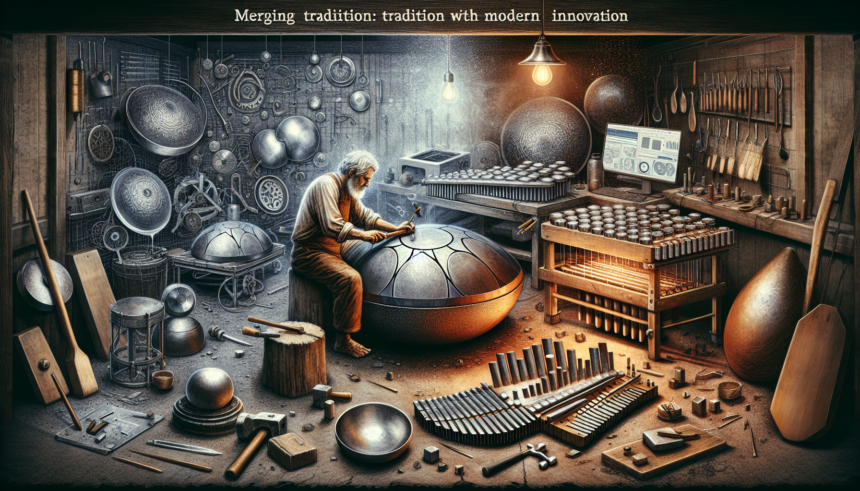Handpans are mesmerizing musical instruments characterized by their ethereal, resonant sounds and intricate craftsmanship. The origins of the handpan can be traced back to the early 21st century, making it a relatively modern addition to the world of musical instruments. However, the art of creating handpans draws heavily from ancient metalworking techniques and principles of sound engineering, merging tradition with modern innovation. In this article, we will explore the fascinating world of handpan makers, their detailed processes, and how they continue to revolutionize this unique instrument.
The Origins and Evolution of the Handpan
The handpan, often associated with the Hang drum invented by Felix Rohner and Sabina Schärer in Switzerland in 2000, has its roots in various cultural percussion instruments. The Pans of Trinidad and Tobago, gongs, and steel drums all contributed to the development of the handpan. Rohner and Schärer wanted to create a musical instrument that provided the harmonic sounds and tactile interaction found in a variety of traditional instruments, leading to the creation of the first handpan, named the Hang.
Since then, numerous handpan makers, often referred to as “pan builders” or “pan makers,” have entered the scene, each bringing their unique touch and innovation to the instrument. While the design and function have remained relatively consistent, technological advancements, new materials, and refined craftsmanship have significantly impacted the instrument’s evolution.
Craftsmanship: The Process of Creating a Handpan
Building a handpan requires a deep understanding of acoustics, metallurgy, and precision workmanship. The process begins with selecting the right material, typically high-quality steel. Depending on the desired sound and durability, makers may choose stainless steel or nitrided steel. Some models even employ exotic alloys.
The basic stages of handpan creation include:
1. Shaping the Shells
The first step involves forming two steel shells, which will later be joined together. This is usually achieved through processes such as hydroforming, deep drawing, or manual hammering. This shaping process is crucial as it sets the foundation for the instrument’s final sound.
2. Marking and Pre-Tuning
Once the shells are formed, the maker marks the locations where the notes will be tuned. This pre-tuning phase involves initial hammering or pressing to create the note cavities, also known as tone fields. The placement and depth of these indentations will significantly affect the handpan’s sound quality.
3. Heat Treatment
This step involves treating the shells with heat to modify the steel’s properties, enhancing its resonance and durability. This can also include processes such as nitriding, which improves rust resistance and contributes to a more stable tuning.
4. Fine Tuning
Fine-tuning is arguably the most critical and time-consuming step. It involves meticulously hammering the tone fields to achieve the precise pitch and harmonic balance for each note. This phase requires the maker’s skilled ear and significant experience, as even slight adjustments can greatly influence the overall sound.
5. Assembly
Once the tuning is finalized, the two shells are riveted or glued together. The instrument then undergoes a final tuning check, ensuring all notes resonate harmonically and maintain their pitch over time.
Innovation in Handpan Making
The journey of handpan making doesn’t end with perfecting traditional techniques. Modern innovation plays a vital role in pushing the boundaries of what these instruments can achieve. Some of the key areas where innovation has made a difference include:
1. Materials and Alloys
Researchers and makers continue to experiment with various materials and alloys to find combinations that yield better sound quality, durability, and resistance to environmental factors. Advanced metallurgy allows for the creation of handpans with unique tonal qualities and extended longevity.
2. Tuning Technologies
While traditional handpan tuning relies heavily on the maker’s ear, modern technologies like electronic tuners and software-assisted tuning methods are becoming more common. These tools enable higher precision and consistency, allowing even novice makers to achieve professional-level tuning with practice.
3. Customization and Acoustic Engineering
Advanced acoustic engineering principles are increasingly being applied to customize handpans for specific sound characteristics. Makers can now design instruments with unique scales, additional notes, or even hybrid models that merge different acoustic properties, providing a broader range of musical possibilities.
4. Sustainable Practices
Many modern handpan makers are embracing sustainable practices. This includes sourcing eco-friendly materials, minimizing waste during the production process, and even implementing fair trade practices. The goal is to create beautiful instruments without compromising the ethical and environmental responsibilities.
Impact on Music and Culture
The rise of the handpan has had a significant impact on various music genres and cultural practices. The instrument’s unique sound has found its way into meditation, yoga sessions, contemporary music, and even classical compositions. It resonates deeply with audiences seeking a harmonious and soothing auditory experience.
Furthermore, the handpan community has grown substantially, with dedicated festivals, workshops, and online forums where enthusiasts can share their knowledge and experiences. This global community fosters a deeper appreciation for the instrument and provides invaluable support for both new and seasoned players.
Conclusion
The art of handpan making beautifully exemplifies the fusion of traditional craftsmanship and modern innovation. Each handpan is a testament to the maker’s skill, creativity, and dedication to producing an instrument that transcends time and culture. As technology advances and new materials are discovered, the handpan will undoubtedly continue to evolve, offering even more captivating sounds and richer musical experiences. For those seeking an instrument that embodies the essence of artisanal craftsmanship and cutting-edge innovation, the handpan stands as a remarkable choice.
FAQs
Handpans are usually made from high-quality steel, with common materials being stainless steel or nitrided steel. The choice of material affects the instrument’s sound quality, durability, and resistance to environmental factors.
The time required to make a handpan varies depending on the maker and the specific instrument. Generally, it can take anywhere from several days to a few weeks, considering the meticulous shaping, tuning, and assembly processes involved.
Yes, many handpan makers offer customization options. This can include selecting specific scales, adding extra notes, and designing instruments with unique tonal qualities. Customization allows players to tailor the instrument to their specific musical preferences.
Modern handpan makers often use electronic tuners and software-assisted tuning methods to achieve higher precision and consistency. These technologies complement traditional tuning techniques, ensuring better sound quality.
Nitriding is a heat treatment process that introduces nitrogen into the steel surface, enhancing its hardness, resistance to corrosion, and durability. This process is crucial for maintaining the handpan’s tuning stability and overall longevity.





